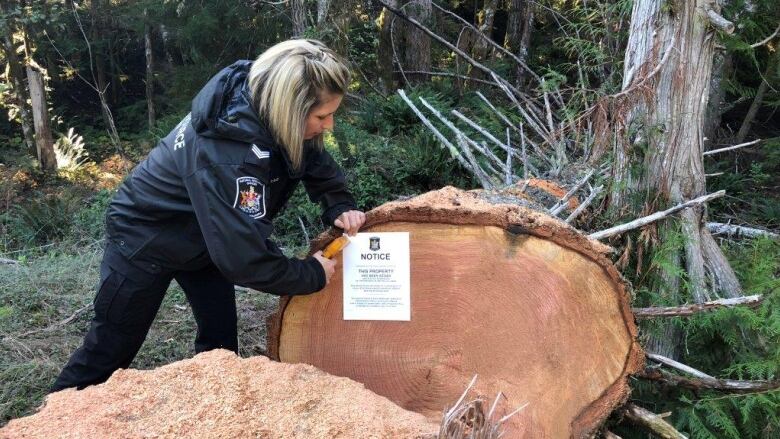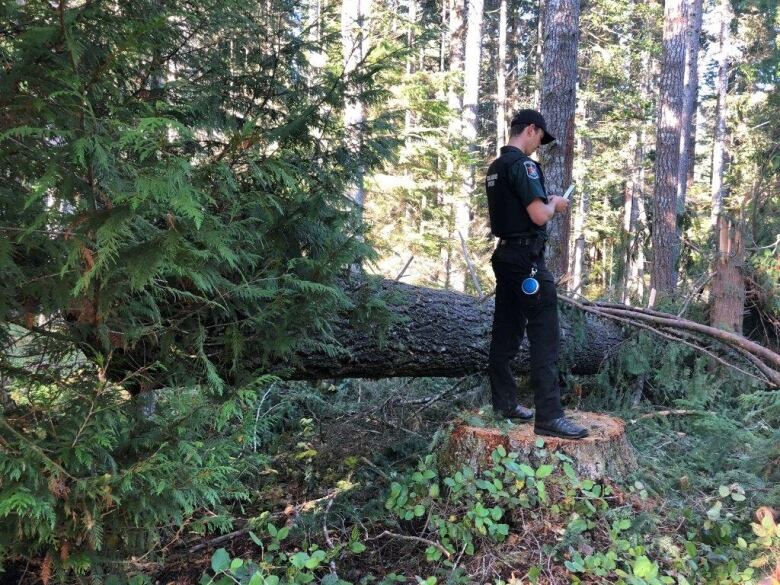Timber theft a growing problem on Vancouver Island, ministry says
Penalties are serious: Up to $1 million in fines, 3 years imprisonment or both

Tree poaching illegally cutting and selling timber from Crown lands is a growing problem on Vancouver Island, according to the Ministry of Forests, Lands, Natural Resource Operations and Rural Development.
Luke Clarke, a natural resourceofficer with the ministry, says his team has identified a number of thefts onsouthern Vancouver Islandwhere towns and cities are close toforested areas.
"We're finding that timber thieves are fairly lazy people, " Clarke said. "They want [the logs] tofall right onto the road. You're going to see stumps covered up with moss if you're driving on forest service roads in many of these areas with the intent of covering up their tracks."

Clarke said the stumps and fallen logs are creating major safety concerns for people working,walking or ridingin the forest. In addition, logs are being taken from highly sensitive ecological areas.
"Under forestry practices, foresters will leave strips of trees around streams and wildlife habitat. Those trees are never going to get cut down," he said. "We have thieves going in there and cutting those trees down which poses a huge environmental impact and invaluable resource that's being removed."
Listen to the full segment on All Points West:
Big penalties
The timber most often stolen include old-growth Douglas fir, cedarand big leaf maple trees.
"Big leaf maple is very trendy right now with live edge slabs. You'll see often in bars. You'll see a nice live edge maple slab with an interesting grain pattern," he said. "It's a beautiful wood."
But there are serious penalties for those caught stealing timber.
Under the Forestand Range Practices Act, a person found guilty of damaging or destroying Crown timber can be fined up to a million dollars or imprisoned up to three years or both.
People failing to properly document and mark stored or transported timber in British Columbia face a fine up to $500,000 or can be imprisoned up to two years. There can also be additional criminal charges for theft and fraud.
The ministry says it has received 548 complaints over the last 10 years. It issued 728 penalties, resultingin fines of $96,600 in violation tickets and $432,439 as the result ofadministrative hearings.
Clarke said there are several investigations currently taking place.

Public encouraged to report
Clarke's team works 24 hours a day, seven days a week withpartners in the forest industry including recreation clubs, fish and game clubs and First Nations. They arealso using surveillanceto catch the poachers.
Yet Clark said the natural resource officers depend on the public to report suspicious activities.
"I want to let the public know we need them to be out there. We have a vast and complex geographical area in this province," he said. "We still rely on the public's eyes and ears."
Thenumber to call to reporttimber poachingis 1-877-952-7277 or #7277 on most cellphone networks.
With files from All Points West












_(720p).jpg)


 OFFICIAL HD MUSIC VIDEO.jpg)
.jpg)



























































































